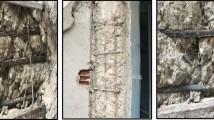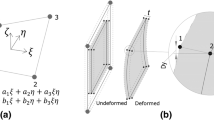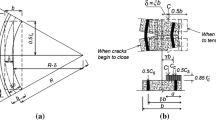Abstract
This paper aimed at analytically investigating the simultaneous effects of the shear-lag and warping torsion on the performance of non-rectangular reinforced concrete (RC) shear walls. Under the concurrent action of shear and axial loadings, the induced warping deformation due to the shear-lag as well as the warping torsion has been accounted for in the elastic region. On the strength of the minimum potential energy principle, a general formulation has been derived for the stress distribution of non-rectangular RC shear walls. By introducing the appropriate geometrical assumptions, the established formulations have then been re-written for conventional T-, U-, and L-shapes RC shear walls. The veracity of the results is ascertained through a comparative study employing finite element simulations for a U-shaped wall, and good agreement has been achieved to an extent that the proposed analytical formulation is capable to, respectively, predict the axial deformation and stress distribution with an accuracy of 95 and 90%. Also, the findings for the U-shaped wall indicate that the shear-lag can significantly affect the axial stress distribution and cracking load, and neglecting the influence of this phenomenon can lead to an inaccurate and a non-conservative design. Moreover, the contribution of the shear-lag and warping torsion has separately been highlighted for the U-shaped RC wall considered in this study.




















Similar content being viewed by others
Data availability
Data supporting this study are included within the article and supporting materials.
Abbreviations
- α x, α y :
-
Dimensionless coefficients in warping deformation resulting from the shear-lag in x- and y-directions
- β x, β y :
-
Constants in warping deformation resulting from the shear-lag in x- and y-directions
- γ t :
-
Product of αx and bt
- ε 50 :
-
Strain corresponding to the stress of \(0.50\,f^{\prime}_{{\text{c}}}\) after attaining the maximum compressive strength of concrete
- ε sh :
-
Strain at the onset of hardening stage
- ε su :
-
Strain corresponding to the ultimate strength of steel reinforcement
- ε sy :
-
Strain corresponding to the yield stress of steel reinforcement
- ε t :
-
Strain corresponding to the ultimate tensile strength of concrete
- ε tu :
-
Ultimate tensile strain of concrete
- λ b, λ c, λ t :
-
Constants corresponding to the shear-lag effects in x- and y-directions, and torsional moment
- μ s :
-
The ratio of the maximum tensile stress with shear-lag and warping torsion to the maximum tensile stress of the Bernoulli–Euler assumption
- μ sb, μ sc, μ sd :
-
Contribution of the shear-lag in x- and y-directions, and warping torsion to the additional tensile stress
- ν :
-
Poisson’s ratio of concrete
- П:
-
Total potential energy function
- Пb, Пc :
-
Total potential energy function corresponding to the lateral loads in x- and y-directions
- σ :
-
Axial stress distribution function of RC shear wall
- σ a, σ b, σ c, σ d :
-
Axial stress distribution function under the axial load, lateral load in x- and y-directions, and torsional moment
- \(\overline{\sigma }\) :
-
Stress distribution function with the Bernoulli–Euler assumption
- \(\overline{\sigma }_{\text{b}} ,\overline{\sigma }_{\text{c}}\) :
-
Stress distribution function with the Bernoulli–Euler assumption in x- and y-directions
- τ :
-
Shear stress distribution function of RC shear wall
- ϕ :
-
Torsional moment-induced rotation angle
- ψ :
-
Warping function
- A :
-
Cross-sectional area of the wall
- B :
-
Bi-moment
- b fbL, b fbR, b ftL, b flR :
-
Widths of the left-side bottom flange, right-side bottom flange, left-side top flange, and right-side top flange
- b t :
-
Horizontal component of the centroid coordinate of the wall in (\(\hat{x},\hat{y}\)) coordinate
- C w :
-
Warping constant
- d c :
-
Confined length of the section
- E :
-
Equivalent modulus of elasticity of the wall
- e c :
-
Clear cover
- e x, e y :
-
Eccentricity of the lateral loads in y- and x-directions from the shear center
- f u :
-
Ultimate stress of steel reinforcement
- f y :
-
Yield stress of steel reinforcement
- \(f^{\prime}_{{\text{c}}}\) :
-
Compressive strength of concrete
- \(f^{\prime}_{{\text{t}}}\) :
-
Tensile strength of concrete
- G :
-
Shear modulus of the wall structure
- H :
-
Height of the wall
- h :
-
Shear wall section height
- h b, h t :
-
Centroid distance from the center of the bottom and top flanges
- I eb, I wb, I ec, I wc :
-
Shear-lag constants in x- and y-directions
- I x, I y :
-
Moment of inertia about x- and y-axes
- Ῑ x, Ῑ y :
-
Moment of inertia about \(\overline{x}\)- and \(\overline{y}\)-axes
- J :
-
Torsional moment of inertia
- N :
-
Applied axial loading
- \(M_{{\overline{x}}} ,M_{{\overline{y}}}\) :
-
Moment of the section about \(\overline{x}\) - and \(\overline{y}\) -axes
- q :
-
Axial stress of RC shear wall
- s x, s y :
-
Shear-lag induced additional lateral deformation in x- and y-directions
- t fb t ft, t w :
-
Thickness of the bottom flange, top flange, and web
- U fb U ft, U w :
-
Strain energy functions corresponding to the bottom flange, top flange, and web of the section
- u :
-
Axial deformation function of RC shear wall
- u a, u b, u c, u d :
-
Axial deformation function induced by axial load, lateral load in x- and y-directions, and torsional moment
- u wb, u wc :
-
Shear-lag constants in x- and y-directions
- V L :
-
Potential energy due to the external loads
- V Lb, V Lc :
-
Potential energy due to the external loadings in x- and y-directions
- V x, V y :
-
Lateral loadings in x- and y-directions
- V x (max), V y (max) :
-
Maximum calculated lateral load in x- and y-directions before cracking, based on the Bernoulli–Euler assumption
- \(V^{\prime}_{x(\max )} ,V^{\prime}_{y(\max )}\) :
-
Maximum calculated lateral load in x- and y-directions before cracking due to the shear-lag and warping torsion
- w x w y :
-
Lateral deformation of the wall in x- and y-directions before cracking, based on the Bernoulli–Euler assumption
- (x c, y c):
-
Shear center coordinate of the section
- (x G, y G):
-
Centroid coordinate of the section
References
Kwan AKH. Shear lag in shear/core walls. J Struct Eng. 1996;122:1097–104.
Hoult RD. Shear lag effects in reinforced concrete C-shaped walls. J Struct Eng. 2019;145:4018270.
Fahmy EH, Robinson H. Analyses and tests to determine the effective widths of composite beams in unbraced multistorey frames. Can J Civ Eng. 1986;13:66–75.
Cambronero-Barrientos F, Díaz-del-Valle J, Martínez-Martínez J-A. Beam element for thin-walled beams with torsion, distortion, and shear lag. Eng Struct. 2017;143:571–88.
Li X, Wan S, Mo YL, Shen K, Zhou T, Nian Y. An improved method for analyzing shear lag in thin-walled box-section beam with arbitrary width of cantilever flange. Thin Walled Struct. 2019;140:222–35.
Argyridi AK, Sapountzakis EJ. Advanced analysis of arbitrarily shaped axially loaded beams including axial warping and distortion. Thin Walled Struct. 2019;134:127–47.
Lezgy-Nazargah M, Vidal P, Polit O. A sinus shear deformation model for static analysis of composite steel-concrete beams and twin-girder decks including shear lag and interfacial slip effects. Thin Walled Struct. 2019;134:61–70.
Luo D, Zhang Z, Li B. The effects of shear deformation in non-rectangular steel reinforced concrete structural walls. J Constr Steel Res. 2020;169: 106043.
Zhou M, Zhang Y, Lin P, Zhang Z. A new practical method for the flexural analysis of thin-walled symmetric cross-section box girders considering shear effect. Thin Walled Struct. 2022;171: 108710.
Palermo D, Vecchio FJ, Solanki H. Behavior of three-dimensional reinforced concrete shear walls. ACI Struct J. 2002;99:81–9.
Thomsen JH IV, Wallace JW. Displacement-based design of slender reinforced concrete structural walls—experimental verification. J Struct Eng. 2004;130:618–30.
Zhang Z, Li B. Seismic performance assessment of slender T-shaped reinforced concrete walls. J Earthq Eng. 2016;20:1342–69.
Constantin R, Beyer K. Behaviour of U-shaped RC walls under quasi-static cyclic diagonal loading. Eng Struct. 2016;106:36–52.
Brueggen BL, French CE, Sritharan S. T-shaped RC structural walls subjected to multidirectional loading: test results and design recommendations. J Struct Eng. 2017;143:4017040.
Ma J, Zhang Z, Li B. Experimental assessment of T-shaped reinforced concrete squat walls. ACI Struct J. 2018;115:621–34.
Hoult R, Beyer K. RC U-shaped walls subjected to in-plane, diagonal, and torsional loading: new experimental findings. Eng Struct. 2021;233: 111873.
Palermo D, Abdulridha A, Charette M. Flange participation for seismic design of reinforced concrete shear walls. 2007. p. 1210–19
Zhang Z, Luo D, Li B. Strain nonlinearity and shear lag effect in compressive flange of reinforced concrete structural walls. ACI Struct J. 2021;118.
Khaloo A, Tabiee M, Abdoos H. A numerical laboratory for simulation of flanged reinforced concrete shear walls. J Numer Methods Civ Eng. 2022;6:92–102.
Reissner E. Analysis of shear lag in box beams by the principle of minimum potential energy. Q Appl Math. 1946;4:268–78.
Song Q, Scordelis AC. Shear-lag analysis of T-, I-, and box beams. J Struct Eng. 1990;116:1290–305.
Haji-Kazemi H, Company M. Exact method of analysis of shear lag in framed tube structures. Struct Des Tall Build. 2002;11:375–88.
Building Code Requirements for Structural Concrete (ACI 318-19). 2020.
Iranian Concrete Code of Practice (ABA). Planning and management organization, PN, 120. 2021.
E. CEN. 8—Design of structures for earthquake resistance—Part 1: general rules, seismic actions and rules for building. London: Br. Stand. Institute; 2004.
Uniform Building Code, 1994, International Code Council; 1994.
B.S. BS5400, Steel, concrete and composite bridges, Part 5, code of practice for design of composite bridges. London: Br. Stand. Institution; 1979.
Brueggen BL. Performance of T-shaped reinforced concrete structural walls under multi-directional loading. Ph.D. Dissertation. 2009.
Choi C-S, Ha S-S, Lee L-H, Oh Y-H, Yun H-D. Evaluation of deformation capacity for RC T-shaped cantilever walls. J Earthq Eng. 2004;8:397–414.
Beyer K, Dazio A, Priestley MJN. Quasi-static cyclic tests of two U-shaped reinforced concrete walls. J Earthq Eng. 2008;12:1023–53.
Zhang Z, Li B. Shear lag effect in tension flange of RC walls with flanged sections. Eng Struct. 2017;143:64–76.
Shi Q, Wang B. Simplified calculation of effective flange width for shear walls with flange. Struct Des Tall Spec Build. 2016;25:558–77.
Liu C, Wei X, Wu H, Li Q, Ni X. Research on shear lag effect of t-shaped short-leg shear wall. Period Polytech Civ Eng. 2017;61:602–10.
Ni X, Cao S. Shear lag analysis of I-shaped structural members. Struct Des Tall Spec Build. 2018;27: e1471.
Lu N, Li W. Analytical study on the effective flange width for T-shaped shear walls. Period Polytech Civ Eng. 2020;64:253–64.
Tabiee M, Abdoos H, Khaloo A. Investigation of the shear-lag effects on the response of L-shaped RC shear walls. J Struct Constr Eng. 2022. https://doi.org/10.22065/jsce.2022.340500.2804.
Abdoos H, Khaloo A, Tabiee M. Effective width estimation of L-shaped RC shear walls using EPR algorithm. Sharif J Civ Eng. 2023;38(2):63–71.
Lue DM, Liu J-L, Lin C-H. Numerical evaluation on warping constants of general cold-formed steel open sections. Steel Struct. 2007;7:297–309.
Carpinteri A, Lacidogna G, Nitti G. Open and closed shear-walls in high-rise structural systems: static and dynamic analysis. Curved Layer Struct. 2016;3(1):154–71.
Capdevielle S, Grange S, Dufour F, Desprez C. A multifiber beam model coupling torsional warping and damage for reinforced concrete structures. Eur J Environ Civ Eng. 2016;20:914–35.
Di Re P, Addessi D, Filippou FC. Mixed 3D beam element with damage plasticity for the analysis of RC members under warping torsion. J Struct Eng. 2018;144:4018064.
R. Constantin, K. Beyer. Non-rectangular RC walls: a review of experimental investigations. In: 2nd European conference earthquake engineering seismology, 2014
Khaloo H, Tabiee AR, Abdoos M. Analytical study of distribution of shear lag-induced stress in non-rectangular reinforced concrete shear walls. In: 12th international congress on civil engineering, 2021. p. 8.
Lezgy-Nazargah M, Vidal P, Polit O. A quasi-3D finite element model for the analysis of thin-walled beams under axial–flexural–torsional loads. Thin Walled Struct. 2021;164: 107811.
Khaloo H, Tabiee AR, Abdoos M. Analytical study of distribution of shear lag-induced stress in non-rectangular reinforced concrete shear walls. In: 12th international congress on civil engineering, Mashhad, Iran [In Persian], 2021. p. 8.
Tabiee M. Study of shear lag effect on non-rectangular RC shear walls, M.Sc. Thesis, Sharif University of Technology, 2021.
Martin H. Elasticity-theory, applications, and numerics. Elsevier Science Publishing Company; 2014.
Vlasov VZ. Thin-walled elastic rods. Moscow: Fizmatgiz; 1959.
Bleich F. Buckling strength of metal structures. Cardnr: Mc Graw-Hill B. Company Inc; 1952. p. 51–12588.
I. canadien de la construction en acier, D. Beaulieu, Calcul des charpentes d’acier, [Willowdale, Ont.]: Institut canadien de la construction en acier, 2003.
Galambos TV. Structural members and frames. Upper Saddle River: Prentice-Hall; 1968.
Seaburg PA, Carter CJ. Torsional analysis of structural steel members, 1997.
Galambos TV. Guide to stability design criteria for metal structures. New York: Wiley; 1998.
Bryan SS, Alex C. Tall building structures: analysis and design (1991)
Ma J, Li B. Experimental and analytical studies on H-shaped reinforced concrete squat walls. ACI Struct J. 2018;115:425–38.
Behrouzi AA, Mock AW, Lehman DE, Lowes LN, Kuchma DA. Impact of bi-directional loading on the seismic performance of C-shaped piers of core walls. Eng Struct. 2020;225: 111289.
Roy HEH, Sozen MA. Ductility of concrete. Spec Publ. 1965;12:213–35.
Park R, Paulay T. Reinforced concrete structures. New York: Wiley; 1975.
Acknowledgements
The authors highly appreciate the supports provided by the Center of Excellence in Composite Structures and Seismic Strengthening (CECSSS) at Sharif University of Technology (SUT).
Author information
Authors and Affiliations
Corresponding author
Ethics declarations
Conflict of interest
The authors declare that there is no conflict of interests regarding the publication of this paper.
Ethical approval
This material is the authors' own original work, which has not been previously published elsewhere. The paper is not currently being considered for publication elsewhere. The paper reflects the authors' own research and analysis in a truthful and complete manner. The paper properly credits the meaningful contributions of co-authors and co-researchers. All authors have been personally and actively involved in substantial work leading to the paper, and will take public responsibility for its content. I agree with the above statements and declare that this submission follows the policies of journal as outlined in the Guide for Authors and in the Ethical Statement.
Additional information
Publisher's Note
Springer Nature remains neutral with regard to jurisdictional claims in published maps and institutional affiliations.
Appendix
Appendix
The geometrical properties of a flanged RC shear wall with an arbitrary section are listed in Table 4. Moreover, as RC shear walls with T-, U-, and L-shaped sections are more commonly utilized in comparison with other non-rectangular sections, Tables 5, 6, 7 respectively summarize the coefficients required for computation of the axial deformation and stress distribution of the above-described sections.
Rights and permissions
Springer Nature or its licensor (e.g. a society or other partner) holds exclusive rights to this article under a publishing agreement with the author(s) or other rightsholder(s); author self-archiving of the accepted manuscript version of this article is solely governed by the terms of such publishing agreement and applicable law.
About this article
Cite this article
Tabiee, M., Abdoos, H. & Khaloo, A. Concurrent effects of the shear-lag and warping torsion on the performance of non-rectangular RC shear walls. Archiv.Civ.Mech.Eng 23, 138 (2023). https://doi.org/10.1007/s43452-023-00663-1
Received:
Revised:
Accepted:
Published:
DOI: https://doi.org/10.1007/s43452-023-00663-1




